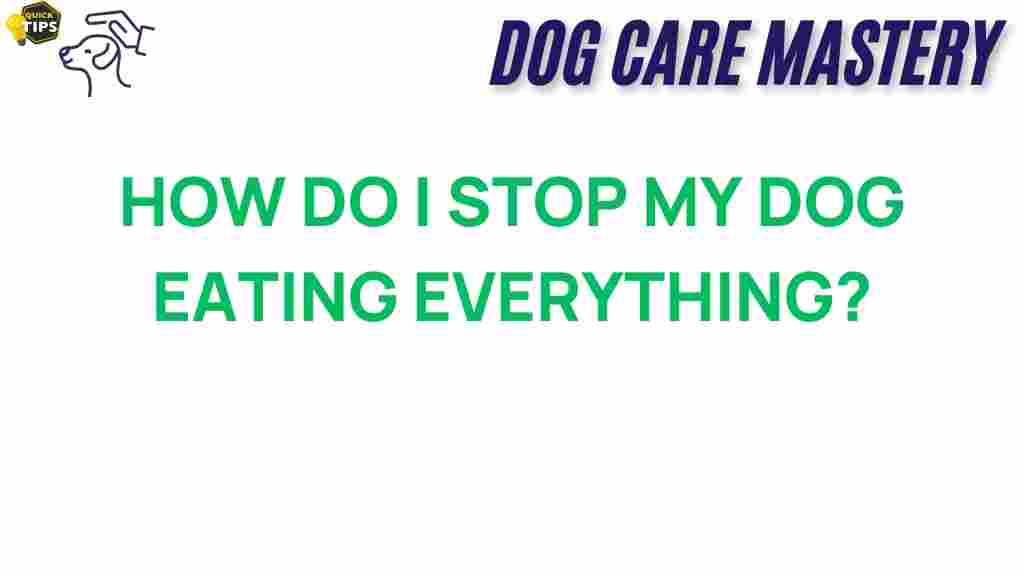Understanding Dog Behavior: How to Stop Your Dog from Eating Everything
As a dog owner, one of the most perplexing behaviors you might encounter is your furry friend’s tendency to eat everything in sight. From leaves to trash and even socks, dogs often seem to have an insatiable appetite for non-food items. Understanding the underlying dog behavior that drives this habit is crucial for addressing it effectively. In this article, we’ll explore why dogs may engage in this behavior and provide a comprehensive guide on how to stop your dog from eating everything.
Why Do Dogs Exhibit This Behavior?
Before diving into solutions, it’s essential to understand the reasons behind this behavior. Dogs may eat non-food items for various reasons, including:
- Curiosity: Dogs are naturally curious creatures and may explore their environment by tasting everything.
- Hunger: If a dog is not getting enough nutrients from their diet, they may seek out additional sources of food.
- Boredom: An under-stimulated dog may resort to eating unusual items as a way to entertain themselves.
- Attention-Seeking: Some dogs learn that eating inappropriate items gets a reaction from their owners, whether positive or negative.
- Stress or Anxiety: Dogs may eat unusual items as a coping mechanism for stress or anxiety.
Step-by-Step Process to Stop Your Dog from Eating Everything
Now that we understand the reasons behind this behavior, let’s explore a structured approach to address it.
Step 1: Assess Your Dog’s Diet
The first step in curbing this behavior is to ensure your dog is receiving a balanced and nutritious diet. Consult with your veterinarian to evaluate your dog’s food and make any necessary adjustments.
Step 2: Increase Exercise and Mental Stimulation
A tired dog is less likely to engage in destructive behavior. Increase your dog’s physical activity with regular walks, playtime, and engaging activities. Consider incorporating:
- Interactive toys that challenge their minds.
- Agility training or obedience classes.
- Frequent visits to the dog park for socialization.
Step 3: Provide Appropriate Chew Toys
Ensure your dog has access to safe, durable chew toys. This not only satisfies their chewing instinct but also diverts their attention from inappropriate items. Look for toys that are:
- Durable and safe for their size.
- Engaging and interesting to chew on.
- Capable of being filled with treats to make them more appealing.
Step 4: Use Training Techniques
Training your dog to understand commands like “leave it” or “drop it” can be immensely helpful. Consistent training sessions will reinforce good behavior. Here are some tips:
- Use positive reinforcement with treats and praise when your dog obeys commands.
- Practice commands in various settings to generalize the behavior.
- Be patient and consistent; training takes time.
Step 5: Manage the Environment
Prevent access to items you don’t want your dog to eat. This could include:
- Securing trash cans with lids or placing them in cabinets.
- Keeping small items like shoes and socks out of reach.
- Using baby gates to limit access to certain areas of the house.
Troubleshooting Common Issues
Even with these strategies, you may still encounter challenges. Here are some troubleshooting tips:
1. If Your Dog is Still Eating Everything
If you notice your dog continues to eat non-food items despite your efforts, it may be a sign of underlying anxiety or stress. Consult a veterinarian or a professional dog trainer for further assistance.
2. When to Seek Professional Help
If your dog exhibits signs of severe pica (the eating of non-food items) or if the behavior is accompanied by other concerning signs like vomiting or lethargy, seek veterinary advice immediately. Your veterinarian can rule out medical issues and may recommend a behaviorist.
Conclusion
Stopping your dog from eating everything requires a combination of understanding, training, and environmental management. By implementing the steps outlined above, you can help correct this behavior while ensuring your dog leads a happy, healthy life. Remember, patience is key; behavior modification takes time, but with consistency and love, you can unravel the mystery behind your dog’s eating habits.
For more tips on improving your dog’s behavior, check out our comprehensive guide on dog training techniques. If you’re looking for external resources on dog behavior, visit the American Kennel Club.
This article is in the category Behavior and created by dogcaremastery Team
